
Merlot is a dark blue–colored wine grape variety, that is used as both a blending grape and for varietal wines. The name Merlot is thought to be a diminutive of merle, the French name for the blackbird, probably a reference to the color of the grape. Its softness and "fleshiness", combined with its earlier ripening, makes Merlot a popular grape for blending with the sterner, later-ripening Cabernet Sauvignon, which tends to be higher in tannin.
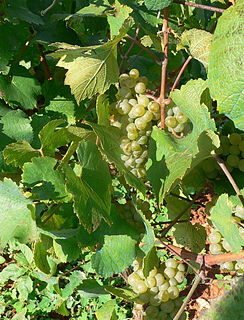
Malvasia is a group of wine grape varieties grown historically in the Mediterranean region, Balearic Islands, Canary Islands and the island of Madeira, but now grown in many of the winemaking regions of the world. In the past, the names Malvasia, Malvazia, and Malmsey have been used interchangeably for Malvasia-based wines; however, in modern oenology, "Malmsey" is now used almost exclusively for a sweet variety of Madeira wine made from the Malvasia grape. Grape varieties in this family include Malvasia bianca, Malvasia di Schierano, Malvasia negra, Malvasia nera, Malvasia nera di Brindisi, Malvasia di Candia aromatica, Malvasia odorosissima, and a number of other varieties.

Alicante Bouschet or Alicante Henri Bouschet is a wine grape variety that has been widely cultivated since 1866. It is a cross of Petit Bouschet and Grenache. Alicante is a teinturier, a grape with red flesh. It is one of the few teinturier grapes that belong to the Vitis vinifera species. Its deep colour makes it useful for blending with light red wine. It was planted heavily during Prohibition in California for export to the East Coast. Its thick skin made it resistant to rot during the transportation process. The intense red color was also helpful for stretching the wine during prohibition, as it could be diluted without detracting from the appearance. At the turn of the 21st century, Alicante Bouschet was the 12th most planted red wine grape in France with sizable plantings in the Languedoc, Provence and Cognac regions. In 1958, Alicante Bouschet covered 24,168 hectares ; by 2011, plantings represented less than 4,000 hectares. This scenario is largely reversed in other regions of Europe, and in southern Portugal, where its wines are highly prized and frequently outscore traditional autochthonous varieties.

Carignan is a red grape variety of Spanish origin that is more commonly found in French wine but is widely planted throughout the western Mediterranean and around the globe. Along with Aramon, it was considered one of the main grapes responsible for France's wine lake and was a substantial producer in jug wine production in California's Central Valley but in recent years, it has been reborn as a flagship wine for many cellars in the south of France as well as in Catalonia.

Petit Verdot is a variety of red wine grape, principally used in classic Bordeaux blends. It ripens much later than the other varieties in Bordeaux, often too late, so it fell out of favour in its home region. When it does ripen it adds tannin, colour and flavour, in small amounts, to the blend. Petit verdot has attracted attention among winemakers in the New World, where it ripens more reliably and has been made into single varietal wine. It is also useful in 'stiffening' the mid palate of Cabernet Sauvignon blends.

Portuguese wine is the result of traditions introduced to the region by ancient civilizations, such as the Phoenicians, Carthaginians, Greeks, and mostly the Romans. Portugal started to export its wines to Rome during the Roman Empire. Modern exports developed with trade to England after the Methuen Treaty in 1703. From this commerce a wide variety of wines started to be grown in Portugal. And, in 1758, one of the first wine-producing regions of the world, the Região Demarcada do Douro was created under the orientation of Marquis of Pombal, in the Douro Valley. Portugal has two wine-producing regions protected by UNESCO as World Heritage: the Douro Valley Wine Region and Pico Island Wine Region. Portugal has a big variety of local kinds, producing a very wide variety of different wines with distinctive personality.
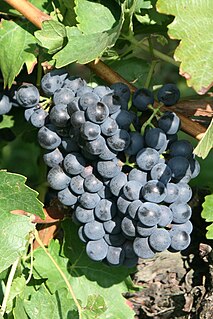
Blauer Portugieser is a red Austrian, Slovenian wine and German wine grape found primarily in the Rheinhessen, Pfalz and wine regions of Lower Austria and Slovenia. It is also one of the permitted grapes in the Hungarian wine Egri Bikavér. In Germany, the cultivated area covered 4,551 hectares or 4.5% of the total vineyard area in 2007. Wine cellars usually vinify a simple light red wine, which is characterized by a fresh, tart and light body. It is also frequently vinified as a rosé. Blauer Portugieser is also very well suited as table grapes; however, it is not sold as such because the selling of wine grapes as table grapes is not permitted in the European Union. Since 2000, higher quality wines have been vinified from Portugieser grapes. The use of oak provides additional aromas in order to compete with Bordeaux varieties. DNA profiling has shown that Blauer Portugieser is a cross between Grüner Silvaner and Blaue Zimmettraube. Historical ampelographic sources have provided very solid evidence that the geographic area of origin of the variety is Lower Styria.
Colares is a Portuguese wine region centered on the Colares municipality in Estremadura region. The region has Portugal's highest wine classification as a Denominação de Origem Controlada (DOC). Located along the southwestern Atlantic coast, vineyards in the area are protected from the strong ocean winds by sandy dunes. In 1940s, vineyards covered 2,500 acres but have since been reduced by suburbanization to 50 acres. Between 1934 and 1994, only the local co-op could use the Colares appellation. Because grapevines there are grown directly upon the sand, and phylloxera aphids cannot live on sand, Colares vineyards are some of the only European vines that are not grafted upon American rootstocks. The ungrafted Ramisco vines of the Colares region are some of the oldest in Portugal. The region is known for its deep colored, full bodied red wines that are high in astringent tannins.
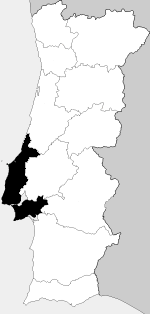
Lisboa, until 2009 named Estremadura, is a Portuguese wine region covering the same areas as the Estremadura region, and taking its name from the country's capital. The region is classified as a Vinho Regional (VR), a designation similar to a French vin de pays region. While the Beiras and Alentejo VRs are largest geographically, the Lisboa region is Portugal's largest producer of wine by volume. The region stretches from Lisbon along the Atlantic coast to the Bairrada DOC.
Roupeiro is a white Portuguese wine grape planted primarily in the Alentejo and Douro regions. In Alentejo, the grape is known as Alva. In the Douro, it is known as Codega.
Arinto or Arinto de Bucelas is a white Portuguese wine grape planted primarily in the Bucelas, Tejo and Vinho Verde regions. It can produce high acid wines with lemon notes.
Azal branco is a white Portuguese wine grape planted primarily in the Minho region but with greater expansion to Amarante, Basto, Baião and Vale do Sousa sub-regions. It noted for the high acidity of its wines, and is used for white Vinho Verde. Varietal Azal Branco wines can be somewhat reminiscent of Riesling.
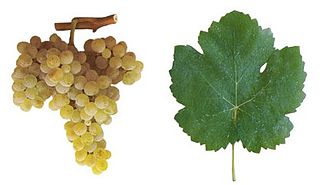
Bical is a white Portuguese wine grape planted primarily in the Bairrada region. It can produce high acid wines and is often used in sparkling wine production.

Cayetana blanca, also known as Cayetana or Jaén, is a white Spanish wine grape. It is grown mainly in the south of Spain, especially in Extremadura and in the Jerez region where it is distilled for use in brandy production.
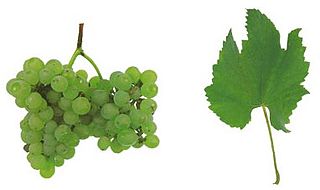
Fernão Pires is a white Portuguese wine grape grown throughout Portugal, especially in the Tejo and Bairrada, where it is also known as "Maria Gomes". This variety is known to produce wines with a spicy aromatic character, though often with delicate exotic fruity notes. Generally not expected to be a long-living wine, this wine is best drunk in its infancy or matured for up to 2 or 3 years. Outside of Portugal there are some significant plantings in South Africa.

Alfrocheiro Preto is a red Portuguese wine grape variety planted primarily in the Dão DOC and Alentejano VR. The grape is known for the deep coloring it can add to wine blends. Under the name Baboso negro, it is considered a minor Spanish red grape variety, growing mainly in the provinces of Zamora and Salamanca, in the region of Castile and León. It is one of the authorized varieties of the La Gomera and El Hierro Denominación de Origen, in the Canary Islands (Spain).

Baga is a red Portuguese wine grape variety planted primarily in the Bairrada DOC. As a varietal, Baga produces tannic wines with high acidity.
Moreto is a red Portuguese wine grape variety that is planted primarily in the Alentejo. As a varietal, the grape makes neutral wines.
Terrantez is a white Portuguese wine grape variety that was once widely used on the island of Madeira to make the sweet fortified wine for which the island is known. Today, the variety is nearly extinct on the island. There are still some limited plantings in the Minho Province where, as Cascal, is a permitted blending variety with Alvarinho and other grapes in the Denominação de Origem Controlada (DOC) wine Vinho Verde. As Terrantez the grape is permitted in several of the Indicação de Proveniencia Regulamentada (IPR) regions of the Azores including Biscoitos IPR on Terceira Island, Graciosa IPR on the white island of Graciosa and Pico IPR on Pico Island.













